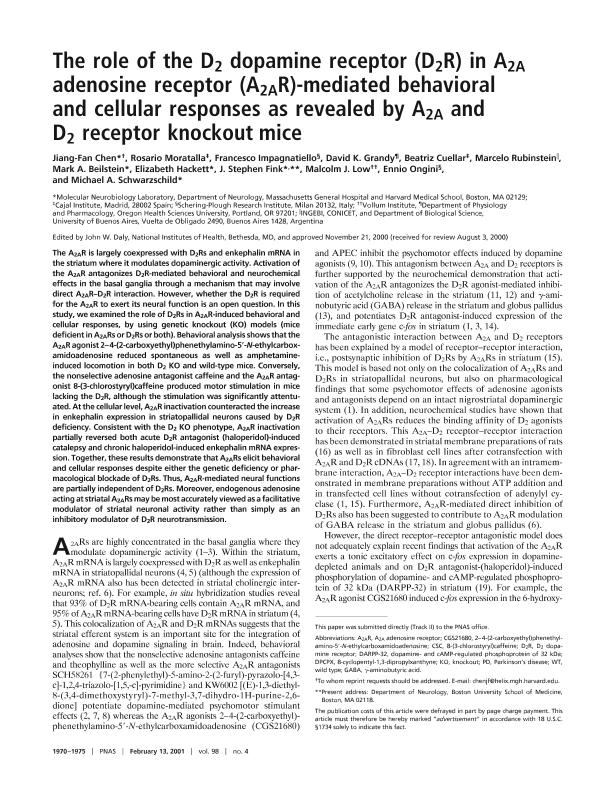Artículo
The role of the D2 dopamine receptor (D2R) in A2A adenosine receptor (A2AR)-mediated behavioral and cellular responses as revealed by A2A and D2 receptor knockout mice
Chen, Jiang Fan; Moratalla, Rosario; Impagnatiello, Francesco; Grandy, David K.; Cuellar, Beatriz; Rubinstein, Marcelo ; Beilstein, Mark A.; Hackett, Elizabeth; Fink, J. Stephen; Low, Malcolm J.; Ongini, Ennio; Schwarzschild, Michael A.
; Beilstein, Mark A.; Hackett, Elizabeth; Fink, J. Stephen; Low, Malcolm J.; Ongini, Ennio; Schwarzschild, Michael A.
 ; Beilstein, Mark A.; Hackett, Elizabeth; Fink, J. Stephen; Low, Malcolm J.; Ongini, Ennio; Schwarzschild, Michael A.
; Beilstein, Mark A.; Hackett, Elizabeth; Fink, J. Stephen; Low, Malcolm J.; Ongini, Ennio; Schwarzschild, Michael A.
Fecha de publicación:
02/2001
Editorial:
National Academy of Sciences
Revista:
Proceedings of the National Academy of Sciences of The United States of America
ISSN:
0027-8424
Idioma:
Inglés
Tipo de recurso:
Artículo publicado
Clasificación temática:
Resumen
The A2AR is largely coexpressed with D2Rs and enkephalin mRNA in the striatum where it modulates dopaminergic activity. Activation of the A2AR antagonizes D2R-mediated behavioral and neurochemical effects in the basal ganglia through a mechanism that may involve direct A2AR-D2R interaction. However, whether the D2R is required for the A2AR to exert its neural function is an open question. In this study, we examined the role of D2Rs in A2AR-induced behavioral and cellular responses, by using genetic knockout (KO) models (mice deficient in A2ARs or D2Rs or both). Behavioral analysis shows that the A2AR agonist 2-4-(2-carboxyethyl)phenethylamino-5′-N-ethylcarboxamidoadenosine reduced spontaneous as well as amphetamine-induced locomotion in both D2 KO and wild-type mice. Conversely, the nonselective adenosine antagonist caffeine and the A2AR antagonist 8-(3-chlorostyryl)caffeine produced motor stimulation in mice lacking the D2R, although the stimulation was significantly attentuated. At the cellular level, A2AR inactivation counteracted the increase in enkephalin expression in striatopallidal neurons caused by D2R deficiency. Consistent with the D2 KO phenotype, A2AR inactivation partially reversed both acute D2R antagonist (haloperidol)-induced catalepsy and chronic haloperidol-induced enkephalin mRNA expression. Together, these results demonstrate that A2ARs elicit behavioral and cellular responses despite either the genetic deficiency or pharmacological blockade of D2Rs. Thus, A2AR-mediated neural functions are partially independent of D2Rs. Moreover, endogenous adenosine acting at striatal A2ARs may be most accurately viewed as a facilitative modulator of striatal neuronal activity rather than simply as an inhibitory modulator of D2R neurotransmission.
Palabras clave:
Dopamina
,
Adenosina
Archivos asociados
Licencia
Identificadores
Colecciones
Articulos(INGEBI)
Articulos de INST.DE INVEST.EN ING.GENETICA Y BIOL.MOLECULAR "DR. HECTOR N TORRES"
Articulos de INST.DE INVEST.EN ING.GENETICA Y BIOL.MOLECULAR "DR. HECTOR N TORRES"
Citación
Chen, Jiang Fan; Moratalla, Rosario; Impagnatiello, Francesco; Grandy, David K.; Cuellar, Beatriz; et al.; The role of the D2 dopamine receptor (D2R) in A2A adenosine receptor (A2AR)-mediated behavioral and cellular responses as revealed by A2A and D2 receptor knockout mice; National Academy of Sciences; Proceedings of the National Academy of Sciences of The United States of America; 98; 4; 2-2001; 1970-1975
Compartir
Altmétricas



